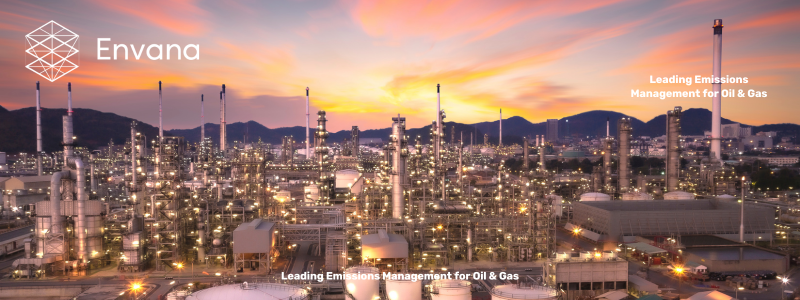
Methane emissions monitoring has become a critical focus area as regulatory pressures and economic considerations continue to drive operational changes within the oil and gas (O&G) industry. As the primary component of natural gas, methane plays a central role in energy production and supply chains.
While methane emissions have traditionally been associated with environmental concerns, their repercussions extend beyond ecological impact to encompass economic and regulatory dimensions. Regulatory scrutiny surrounding greenhouse gas (GHG) emissions is intensifying, with stricter compliance requirements and penalties for non-compliance. Consequently, addressing the methane emissions crisis is not only imperative for environmental sustainability but also essential for safeguarding economic interests and ensuring regulatory compliance.
Alarming New Research Places Spotlight on Methane Emissions
Recent research led by Stanford University has shed light on the significant methane emissions originating from O&G facilities across the U.S. This comprehensive study revealed that methane emissions from a substantial portion of O&G operations surpass official government estimates by roughly three times. The findings underscore the urgency of addressing methane emissions within the industry and highlight the need for more accurate monitoring and mitigation measures.
Understanding the Importance of Accurate Emissions Tracking
Tracking and reporting on GHG emissions is swiftly becoming an essential component of regulatory compliance, risk management, and operational efficiency within the O&G sector. In addition to reducing environmental impact, precise emissions tracking enables companies to identify and mitigate operational inefficiencies, minimize financial losses associated with emissions, and maintain compliance with shifting regulatory frameworks.
By providing real-time insights into emissions levels and trends, accurate emissions tracking empowers companies to make data-driven decisions that optimize performance and enhance sustainability across their operations.
The Growing Significance of Methane Emissions Monitoring
Emerging emission monitoring tools and methods carry profound implications for businesses operating in the O&G sector. In addition to mitigating environmental impacts, timely detection and reduction of methane leaks can also protect valuable O&G resources and assets. By minimizing methane emissions, companies can enhance operational efficiency, reduce financial liabilities, and strengthen their reputation as responsible corporate citizens.
Examination of Business Impact
For O&G companies, effective emissions management is not just a regulatory requirement but also a strategic imperative. The ability to accurately quantify and manage GHG emissions can result in significant cost savings by minimizing product losses and avoiding regulatory penalties. Moreover, proactive emissions management can enhance investor confidence and unlock new opportunities for sustainable growth.
Role in Regulatory Compliance
In an increasingly stringent regulatory landscape, compliance with methane emissions regulations is critical for O&G operators. Accurate tracking and reporting of methane emissions are essential to demonstrate compliance with environmental standards and mitigate legal risks. By investing in advanced technologies and implementing best practices, companies can ensure regulatory compliance while maintaining operational resilience in a rapidly evolving regulatory environment.
Existing Technologies and Strategies
In response to the growing imperative to reduce methane emissions, the O&G industry has been actively exploring various technologies, strategies, and improved maintenance practices. These efforts not only enhance operational efficiency but also contribute to regulatory compliance and risk management.
Repurposed Weather Satellites
One method of methane emissions monitoring involves the use of weather satellites to detect emissions in real-time. By repurposing data from satellites originally designed for weather forecasting, scientists can identify large-emitting events and estimate total emissions with unprecedented accuracy. This technique offers a birds-eye perspective of methane emissions, enabling the identification of leaks and thereby increasing the regulatory risks for O&G companies that lack sufficient emissions tracking and management technologies.
Continuous Methane Monitoring Systems
Another promising solution gaining traction in the industry is continuous methane emissions monitoring systems. These cutting-edge technologies enable real-time detection and quantification of emissions, providing operators with actionable insights to address leaks promptly.
Industry Initiatives and Partnerships
Industry-wide initiatives and partnerships play a crucial role in advancing methane emissions reduction efforts. Collaborative initiatives — such as the Oil and Gas Methane Partnership (OGMP) and the Methane Guiding Principles — bring together industry stakeholders, regulators, and environmental organizations to develop best practices, share knowledge, and drive innovation. By fostering collaboration and collective action, these initiatives accelerate the adoption of methane mitigation technologies and support the industry’s transition to a more sustainable future.
Navigating O&G Methane Regulations
The role of emission monitoring cannot be overlooked in today’s regulatory landscape. While the environmental implications are significant, the economic and compliance factors also play a crucial role in shaping the industry’s response to this challenge.

Download The Easy Guide to Navigating O&G Methane Regulations in 2024 for practical insights for meeting new and upcoming O&G methane regulations. This comprehensive resource provides essential guidance on compliance requirements regarding GHG emissions management. Download your copy today to prepare your company for the future of methane emission regulations in the O&G industry.
Reach out to Envana team to discuss how the Envana platform can help you define your company's methane journey.
Other posts you might be interested in
View All PostsManage New Oil & Gas Regulations With Emissions Management Software
As a business in the oil and gas industry, you need to stay on the cutting edge of emissions management. But this is no easy task. In 2024, companies face a...
Driving Sustainability in LNG, Hydrogen, and Emerging Fuels: How Envana Empowers Companies with Emissions Management Transparency
As the world accelerates its transition to cleaner energy, liquefied natural gas (LNG) and hydrogen are at the forefront of global decarbonization efforts....
Voluntary Carbon Markets: Increased Transparency to Reduce Emissions
On May 28, 2024, the United States White House announced principles to add integrity to voluntary carbon markets (VCM) offsets— and help them grow amid...

